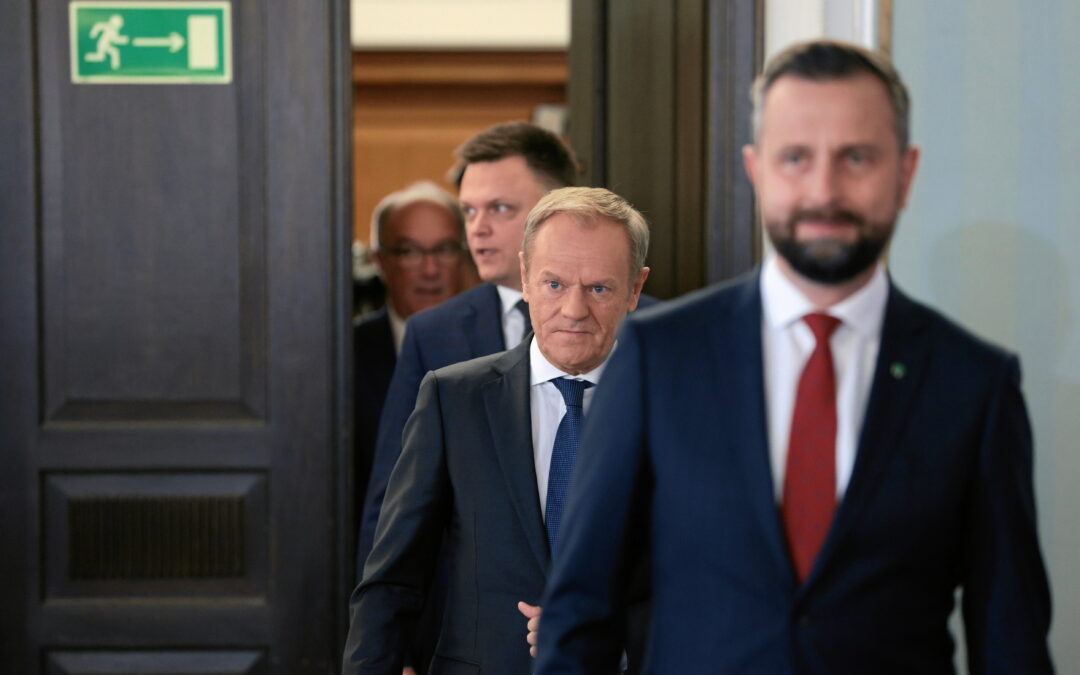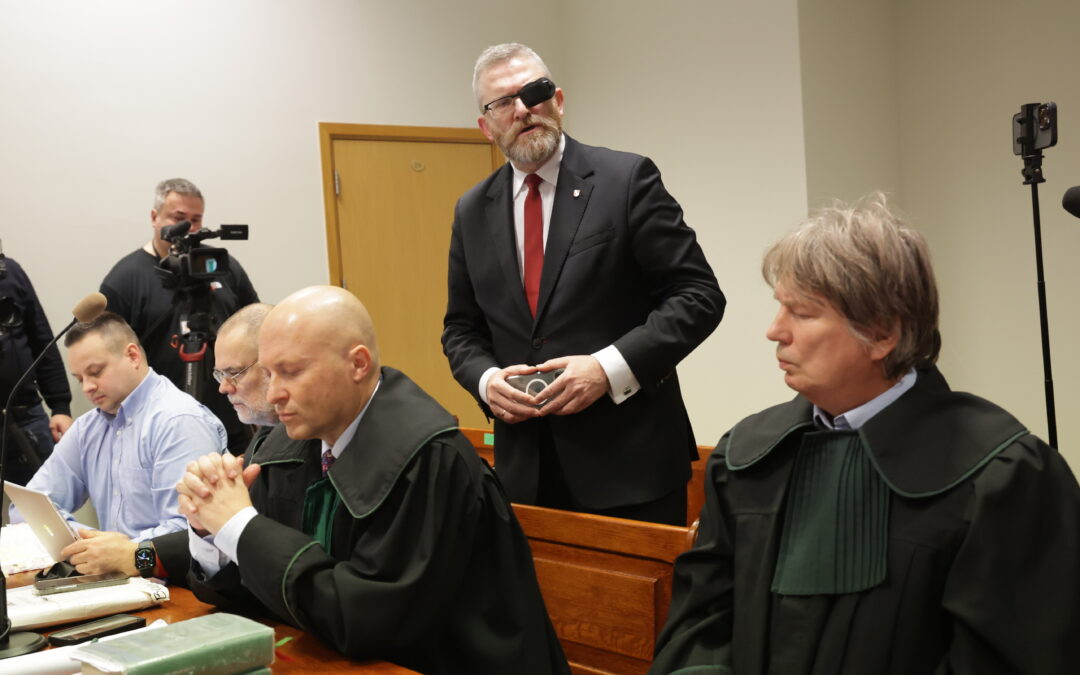By Aleks Szczerbiak
Poland’s opposition parties look set to form the next government because an eclectic liberal-centrist-agrarian electoral coalition won over voters who wanted change but not a return to the pre-2015 status quo ante.
The opposition benefited from an increase in support and turnout in larger towns and among younger voters, but less photogenic middle-aged electors were just as, if not more, significant.
Record turnout, surprising result
The 15 October parliamentary election saw a record 74.4% turnout, the highest in post-communist Poland. This reflected an extremely closely fought and polarised campaign, and what many commentators described as the most important Polish election since the collapse of communism in 1989.
The right-wing Law and Justice (PiS) grouping, Poland’s governing party since 2015, won the largest share of the vote with 35.4%, but this only translated into 194 seats in the 460-member Sejm, the more powerful lower chamber of the Polish parliament, well short of the 231 required for an overall majority. The party does not appear to have enough potential allies to remain in office for an unprecedented third term.
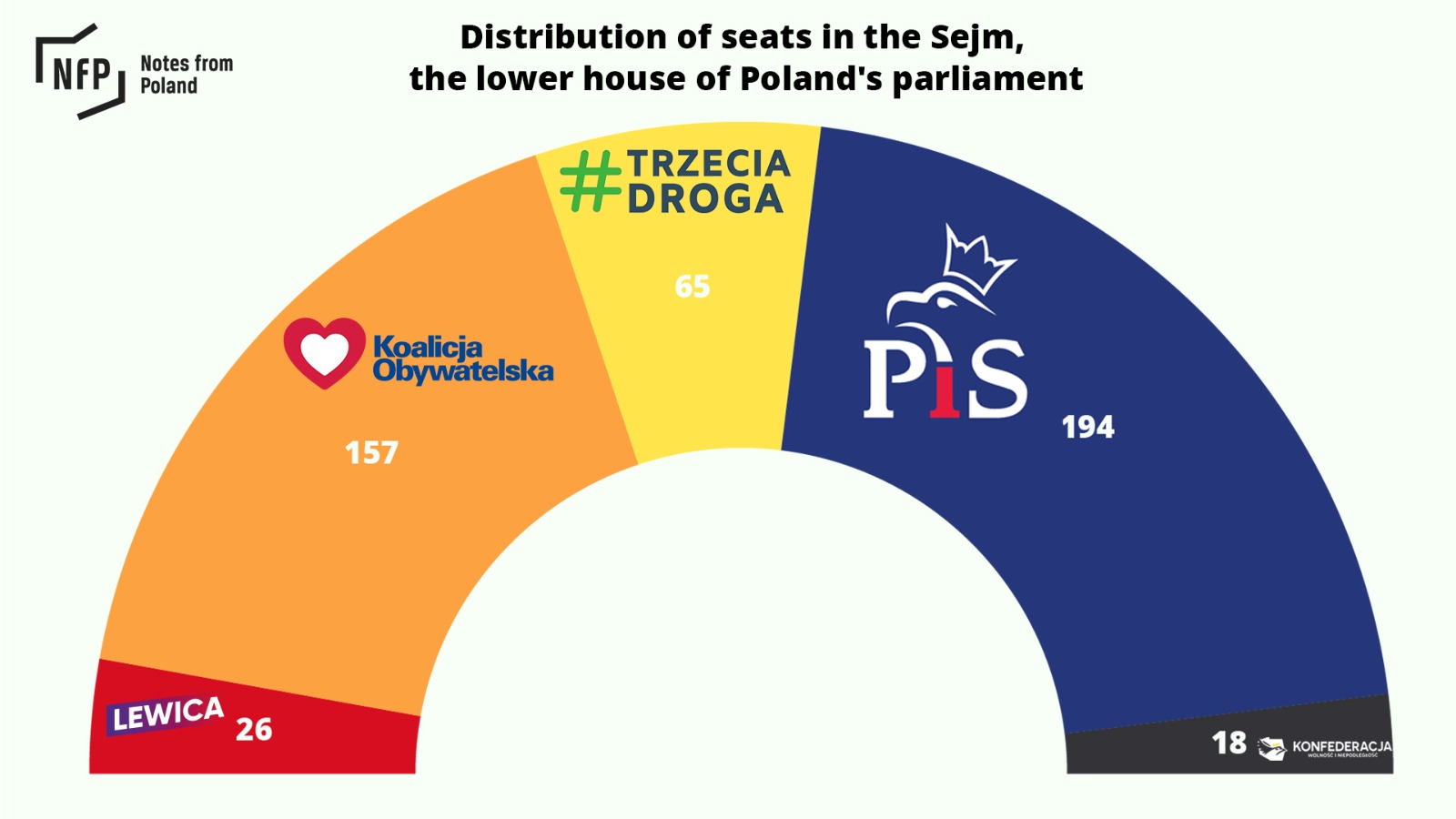
Rather, it was the three main opposition groupings that were able to win a combined 248 seats, comfortably enough to form a coalition government.
The liberal-centrist Civic Platform (PO), Poland’s governing party between 2007-15 led by former prime minister and European Council president Donald Tusk, won 30.7% of the vote and 157 seats.
The Third Way (Trzecia Droga) – an electoral coalition comprising the Polish Peasant Party (PSL), which traces its roots to the 19th-century agrarian movement, and liberal-centrist newcomer Poland 2050 (Polska 2050), founded by TV personality-turned-politician Szymon Hołownia following his strong showing in the 2020 presidential election – took third place with 14.4% of the votes and 65 seats.
Although its vote and seat share went down, an amalgam of left-wing groupings standing on the New Left (Nowa Lewica) party ticket won 8.6% of the votes and 26 seats.
While the two main parties performed broadly as expected, most pre-election polls had not predicted that the opposition parties would be able to form a majority. One of the main reasons for this surprising outcome was that the Third Way won a larger vote share than expected.
Most polls were predicting that that it would only secure around 10%; indeed, at one point there was even speculation that it might not cross the 8% parliamentary representation threshold for electoral coalitions.
The opposition’s election to lose?
Why was the better-than-expected Third Way performance so significant?
Ultimately, there were two main drivers of voting intentions in this election. On the one hand, most Poles were dissatisfied with PiS’s record in government and felt that it was time for a change. The ruling party had been on the backfoot for most of the last three years.
Its initial slump in support was due in large part to a backlash against a hugely controversial October 2020 ruling by Poland’s constitutional tribunal that further tightened Poland’s already restrictive abortion law by invalidating termination of pregnancy in cases where the foetus was seriously malformed or suffered from an incurable disorder.
Although PiS said this was a sovereign decision by an independent body, the government’s opponents argued that the tribunal was under the ruling party’s control and the judgement set off a nationwide wave of street protests, particularly involving younger Poles.
It came at the same time as PiS proposed an animal protection law that many Polish farmers, who constituted a key element of its rural-agricultural core electorate, felt threatened their livelihoods.
The ruling also coincided with a sense that the government was not coping effectively with the second wave of the coronavirus pandemic. Consequently, according to the Politico “poll of polls”, support for PiS fell sharply from 43% in September 2020 to 34% in November and never really recovered.
Together with the economic fallout from the pandemic crisis, the war in neighbouring Ukraine further complicated matters for the government as inflation increased to a 25-year high and eroded the value of the huge welfare payments that were key to PiS’s electoral appeal. Counter-inflationary interest rate increases, in turn, exacerbated the sense of economic insecurity.
While no single crisis reached a critical stage as a political game-changer, their cumulative effect was to erode support for PiS, and for months no opinion poll had predicted that the party would win enough seats to retain its outright parliamentary majority. So the election was very much the opposition’s to lose.
A ‘gateway drug’ for uncertain opposition voters
At the same time, however, PiS’s original election victory also reflected a strong prevailing mood that it was time for change and most Poles did not want a return to the pre-2015 status quo ante.
That was why PiS focused much of its campaign on polarising the election as a straight choice between the incumbent and PO, specifically Tusk. Given that he was prime minister for seven out of the eight years that PI was in office, few politicians better embodied the previous government.
PiS believed that, however frustrated Poles may have been with the current administration, most of them did not want to hand back the reins of power to Mr Tusk.
An important element of PiS’s campaign strategy here was to call multiple referendums on the same day as the parliamentary poll, including four questions on migration, the retirement age and other issues designed specifically to remind voters about various unpopular policies and stances associated with PO.
In fact, most voters followed the opposition’s call to boycott the referendums, which only secured a 40.9% turnout, well short of the 50% required for them to be legally binding.
In the event, the desire for change proved to be the more powerful driver, and here the role of the Third Way was crucial in acting as an effective channel, a sort of “gateway drug”, for picking up uncertain voters who were disillusioned with PiS but reluctant to vote for PO and Tusk.
A number of developments during the final two weeks of the election campaign, when a lot of undecided voters made up their minds, were significant here.
Firstly, PO made a deliberate strategic pivot to depolarise the campaign and tried to persuade voters to support all of the opposition parties and not simply rally around the largest grouping.
At the same time, Hołownia, who earlier in the year appeared to be spent force politically, performed well in the only televised party leaders debate organised by the TVP public broadcaster where he was able to re-recapture the “newness” that characterised his 2020 presidential campaign.
The grouping’s catchy slogan “Either the Third Way or a PiS third term” (Trzecia Droga albo trzecia kadencja PiS) also gained traction, while a decision by the grouping’s leaders not to participate in PO’s huge pre-election “March of a Million Hearts” (Marsz Miliona Serc) demonstration proved an effective way of differentiating themselves from Tusk’s party.
In effect, the Third Way convinced enough voters that it represented something new and different while PiS failed in its efforts to tie the grouping to PO and Tusk in the public consciousness.
Its success appeared to vindicate the arguments of those who were against the opposition parties running as a single electoral list on the grounds that it could lose voters on its “flanks”, or those who rejected the current party duopoly and might instead gravitate towards “challenger” groupings (or simply abstain).
The Confederation underperforms
The other big surprise was the underperformance of the radical right free-market Confederation (Konfederacja) party, which only secured 7.2% of the vote.
Had it obtained the 10% that most final opinion polls were predicting, Confederation would almost certainly have held the balance of power in the new parliament. It surged to double-digit support in the late spring and the early summer but peaked too early and had no idea how to consolidate and build upon this momentum.
It was unable to cope with the intense media scrutiny that it then came under, and particularly to reassure voters put off by some of the more extreme statements made by its candidates and leaders.
The party’s growth was based largely on Confederation professionalising its image by consciously sidelining its most controversial figures while foregrounding younger leaders who were able to communicate the radical programme in a more measured and reasonable way, particularly the charismatic 36-year-old businessman Sławomir Mentzen.
However, although Mentzen was the most effective utiliser of the internet among Polish politicians, he revealed a lack of experience and depth when thrust into the mainstream media spotlight.
The party’s early success also gave its opponents time to develop an attractive counter-offer. Indeed, its underperformance was, to some extent, linked to the better-than-expected result for the Third Way, which pitched its own free-market ideas and hoovered up some of those younger, aspirational voters who were attracted to Confederation as a “third force” challenging the PiS-PO duopoly.
Middle-aged voters count too
According to the exit poll conducted by the Ipsos agency, there was very little evidence of significant voter transfers between the governing and opposition camps.
Rather, the key to the opposition parties’ victory appeared to be their ability to secure the support of 64.1% of “new” electors who did not vote in the previous 2019 poll, compared with only 15.5% who plumped for PiS.
Much of the Western opinion-forming media interpreted this as a revolt of young, urban, female cosmopolitan-liberals against PiS’s predominantly elderly, provincial, male and socially conservative electoral base. The actual picture is more complicated.
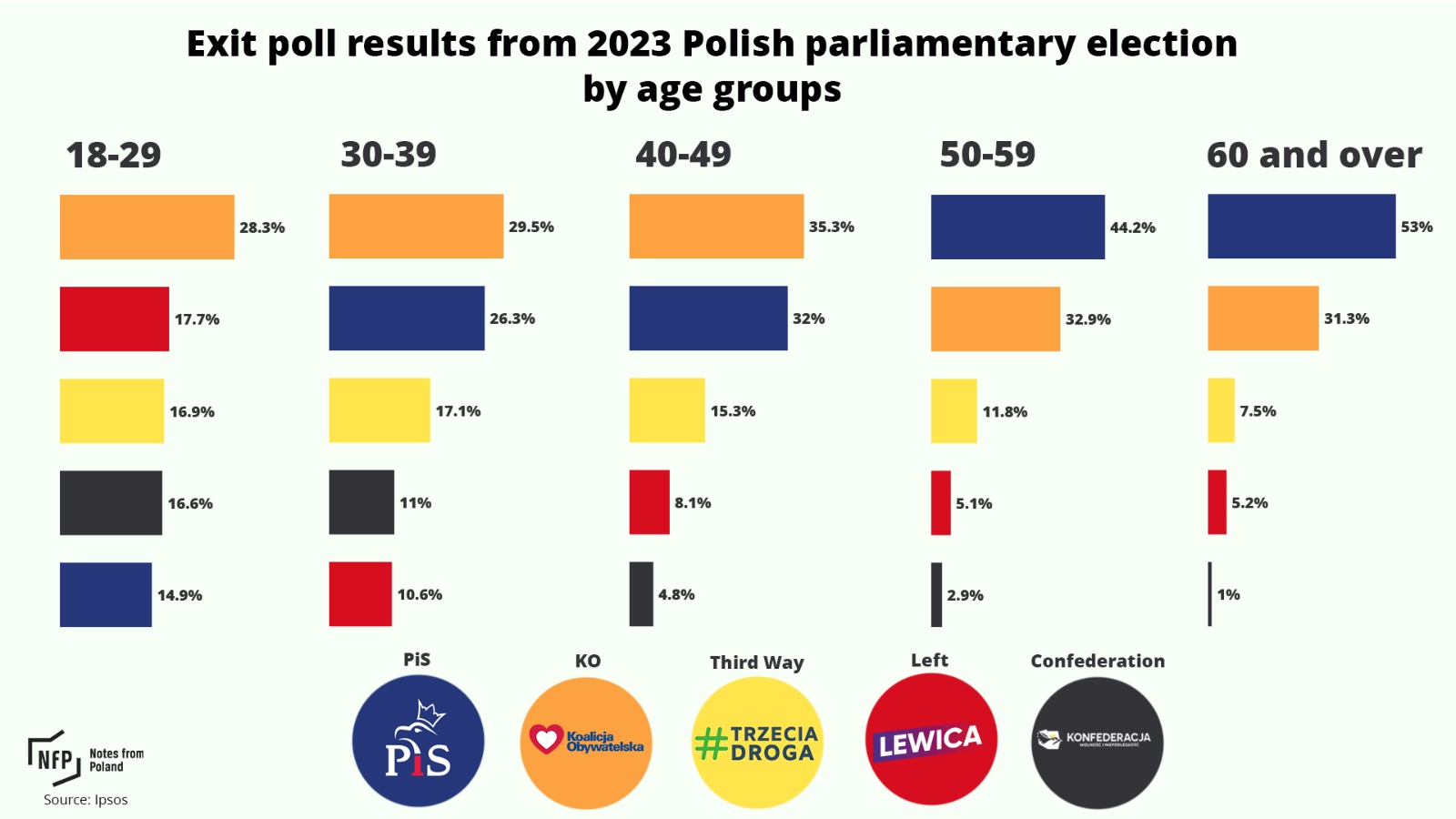
While turnout among women increased from 61.5% to 73.7%, it did so by roughly the same proportion among men, 60.8% to 72.1%. Law and Justice remained the most popular party among women and the fall in its vote share in this demographic, from 43% to 36%, was in line with its average 8.2% drop in support.
Moreover, turnout increased by roughly the same proportion in rural areas (10.3%) and smaller towns (11.3%) as it did in medium-sized towns (12.9%) and cities (11.4%).
The real surge was in larger towns (between 200-500,000 residents) where turnout increased by 18.6% to 82.6%. This was also where PiS saw its largest drop in support, and the opposition’s overall vote share increased by 9.2% compared to its average increase of 5.1%.
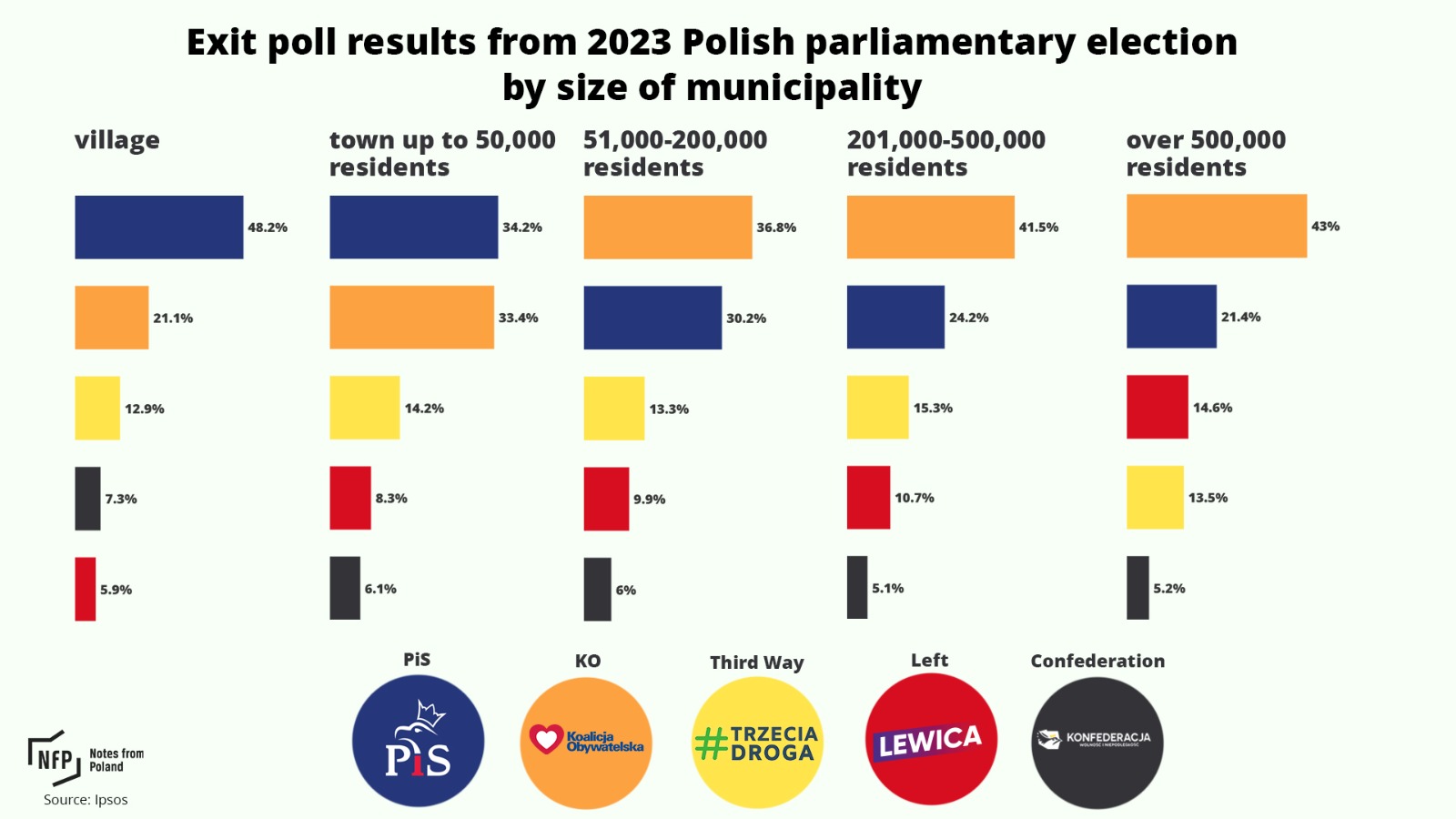
For sure, there was a huge 23.5% increase in turnout among younger (18-30 year-old) voters from just 46.4% to 69.9%, compared with the overall average increase of 12.7%, while electoral participation among over-60s actually fell by 0.7% from 66.2% to 65.5%.
Law and Justice also saw an 11.3% slump fall in support among younger voters from 26.2% to only 14.9% (and 13.6% fall among 30-39 year-olds from 36.9% to 26.3%) while its vote share among over-60s only fell by 2.6% from 55.6% to 53%. At the same time, the overall opposition vote share among younger voters increased by 10.9%, but only by 1.3% among the oldest.
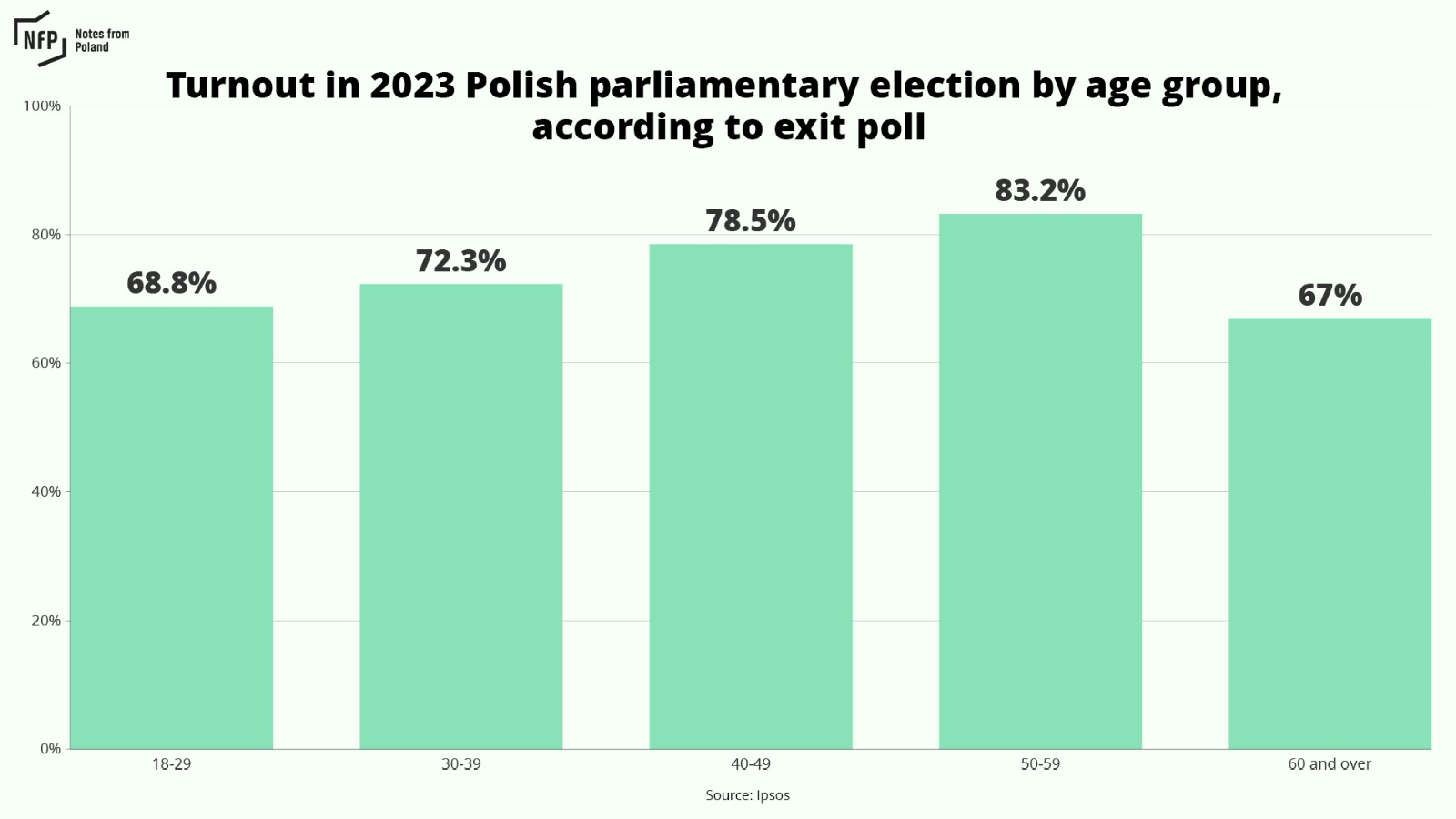
However, the biggest increase in turnout, by 23.8% from 59.6% to 83.4%, was actually among 50-59 year olds. And the most significant increase in support for the opposition parties, by 14.8% from 43.9% to 58.7%, was among the 40-49 year-old age group, where there was a 79.9% turnout.
Indeed, not only were there more older voters than younger ones, year-on-year that disproportion has increased. For example, since the early 2000s, the number of under-30s declined from 10 to 4.5 million while over-60s increased from 7 to 10 million.
Middle-aged voters living in less fashionable towns out of the media glare may not have been as photogenic as young urban hipsters, but their votes counted too and there were many more of them.

Notes from Poland is run by a small editorial team and published by an independent, non-profit foundation that is funded through donations from our readers. We cannot do what we do without your support.
Main image credit: Dawid Zuchowicz / Agencja Wyborcza.pl

Daniel Tilles is editor-in-chief of Notes from Poland. He has written on Polish affairs for a wide range of publications, including Foreign Policy, POLITICO Europe, EUobserver and Dziennik Gazeta Prawna.
